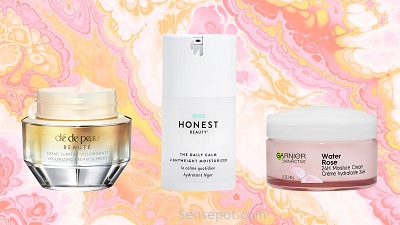The 6 Best Winter and Autumn Moisturizers For Every Skin Type. Dry skin with the advent of cold weather is the main problem of many women. With the onset of the autumn-winter period, the production of our own sebum decreases, and low air temperatures outside and strong winds can dehydrate our skin beyond recognition. As a result, it begins to peel off and becomes dull and irritated. How to choose the very face cream that will nourish and protect our skin during this period?

a cosmetologist and pharmacist by training will help us sort out this issue. Together we will learn what is important to consider when choosing a cream for the cold season. We will learn how to choose the perfect products for different skin types.
How to Choose the Right Winter and Autumn Moisturizers
The first thing you need to pay attention to is the composition. Avoid creams that contain mineral oil or microcrystalline wax. The fact is that such ingredients create an airtight film on the skin, which we take for the velvety and moisturizing of the skin. The film seals in the moisture contained in the skin, creating a moisturizing effect. But, unfortunately, if the skin is dehydrated, then there is essentially nothing to seal and there will be no moisturizing effect. Such a film can disrupt the natural metabolic processes of the epidermis, and the skin will become even drier.
In any case, the choice of face cream should be carried out on an individual basis, taking into account all the features of the epidermis. Therefore, catch a selection of creams and components for different skin types, among which you can definitely find something for yourself.
Dry skin
When choosing a cream for this type of skin, it is important to pay attention to the presence of the following components:
- Ceramides (ceramides);
- Squalane;
- Allantoin ;
- Panthenol.
Oily skin
For owners of this type of skin, you should not choose very dense textures, as their sebaceous glands produce their own sebum. Suitable funds based on the following components:
- Glycerin;
- Hyaluronic acid;
- Plant extracts.
Look for creams that contain natural oil emulsifiers such as olive, shea, almond, coconut, jojoba, and avocado oils. Also, cocoa butter, hyaluronic acid, and amino acids will be excellent basic care for owners of this type of skin.

Combination skin
This type of skin is characterized by a combination of two types: oily most often in the T-zone and dry in the cheek area. With this type of skin, you can observe an oily sheen in the T-zone, enlarged pores, and black dots. Peeling can be observed on the cheeks, especially in the cold season. Girls with this type of skin should avoid very dense textures, as well as components such as mineral oil, shea butter, and coconut oil derivatives. Since these components create a dense, airtight film, which can lead to an increase in oily skin. When choosing a cream, you should pay attention to the following components:
- Almond, olive, and avocado oil;
- Panthenol;
- Amino acids.
Mature and dehydrated skin
Mature skin is considered to be the one that has the first signs of aging: dryness, loss of elasticity, and the appearance of wrinkles. Usually at the age of 35-40, the production of collagen, elastin, and hyaluronic acid decreases. Therefore, for mature skin that is prone to dryness, you should choose products containing the following components:
- Peptides;
- Vitamins;
- Collagen;
- Amino acids;
- Hyaluronic acid.
Sensitive skin
Sensitive skin is the one that is prone to increased irritability, and sensitivity and is characterized by an increased reaction to any external factors. It can be any type of skin: both oily and combination or dry. In order not to provoke skin sensitivity, you should pay attention to components that are aimed at calming and restoring the epidermal barrier:

- Aloe;
- Centella;
- Panthenol;
- Betaine.
Problem skin
This type of skin is most often prone to pimples, rashes, and acne. Excessive sebum production, enlarged pores, and blackheads are also clearly observed. But do not think that such skin does not need to be moisturized, because it is already oily. On the contrary, dehydration of such skin can lead to an aggravation of the problem.
Interesting on the topic DIY Hair Masks: Natural Treatments for Healthy Hair {2023}
Textures for problem skin should be light, and comfortable. It should be avoided in the composition of dense oils such as
- Shea Butter;
- Coconut oil;
- Cacao butter;
- mineral oils and petrochemical derivatives.
Since the task for such skin is not only to moisturize but also to work with sebum regulation, it is worth looking for the following components in the composition:
- Niacinamide ;
- Salicylic acid ;
- White willow extract;
- Zinc;
- Tea tree extract;
- Centella.
What Components in the Cream Will Protect from Wind and Frost
Cream for a cold period of time to protect the face should be of a dense consistency and contain nutrients, vitamin complexes, and vegetable oils. You should pay attention to creams with such components:
- Vegetable oils such as avocado, shea, cocoa, almond, mango, coconut, and olive oil;
- Allantoin and panthenol;
- Glycerin ;
- Vitamin E.
Choose the right cream for autumn and winter to protect the skin from the negative effects of external factors as much as possible, as well as take care of its beauty and health.
FAQs
Q: Can I use the same face cream throughout the year?
A: While it’s possible to use the same face cream, it’s beneficial to switch to a richer, more hydrating formula during autumn and winter to combat dryness.
Q: Are there specific ingredients I should look for in face creams for colder seasons?
A: Yes, look for ingredients like hyaluronic acid, glycerin, ceramides, and natural oils such as jojoba oil or shea butter. These ingredients help retain moisture and nourish the skin.
Q: Is it necessary to apply a face cream during the day if I stay indoors?
A: Yes, indoor heating can still dehydrate your skin. Applying a face cream during the day helps maintain moisture levels and protects against environmental factors.
Q: How often should I exfoliate my skin during autumn and winter?
A: Exfoliating once or twice a week can help remove dry and flaky skin, allowing your face cream to penetrate better and provide optimal hydration.
Q: Can face creams help with sensitive skin during colder months?
A: Yes, there are face creams specifically formulated for sensitive skin. Look for products that are fragrance-free and dermatologist-tested to minimize the risk of irritation.


